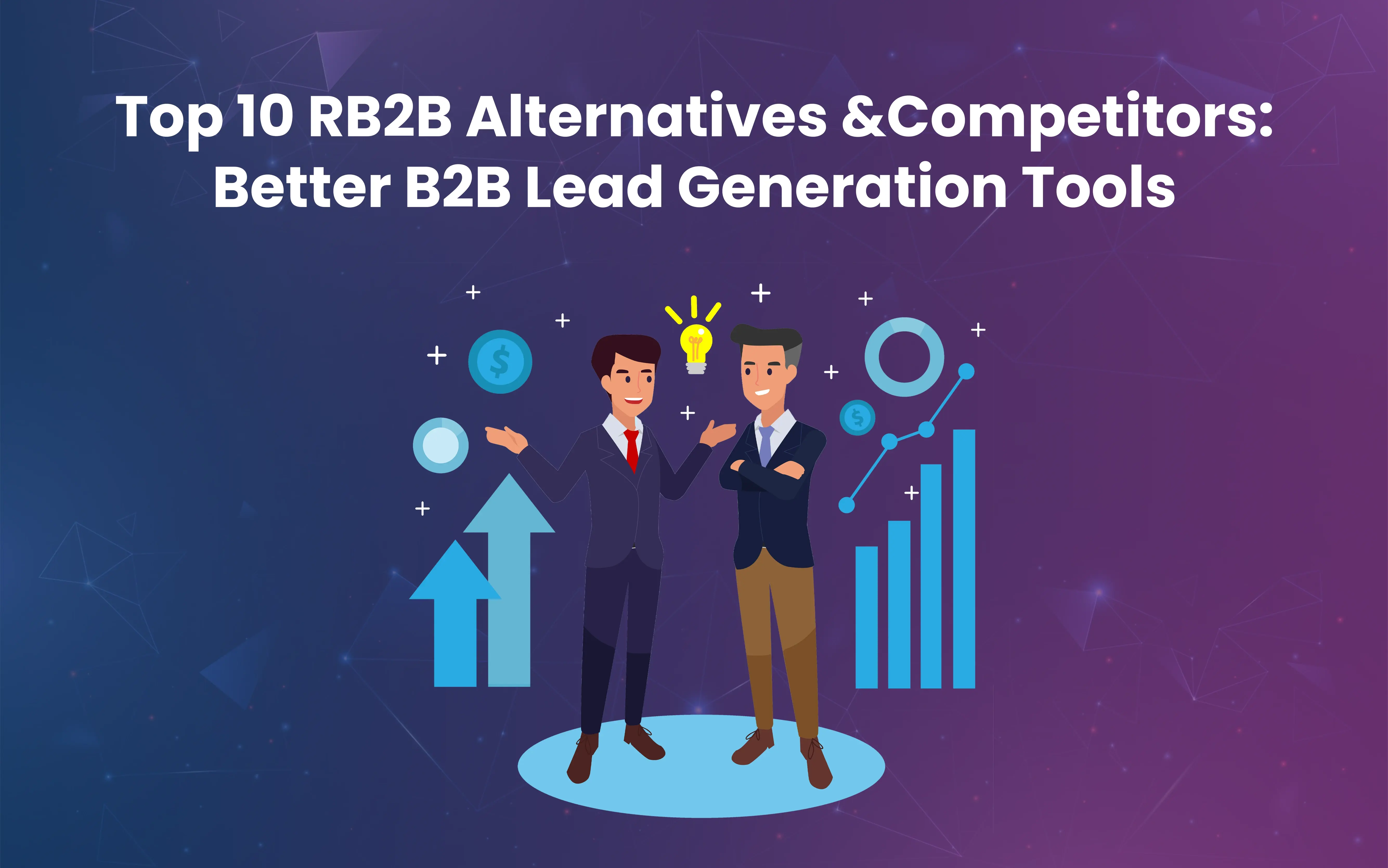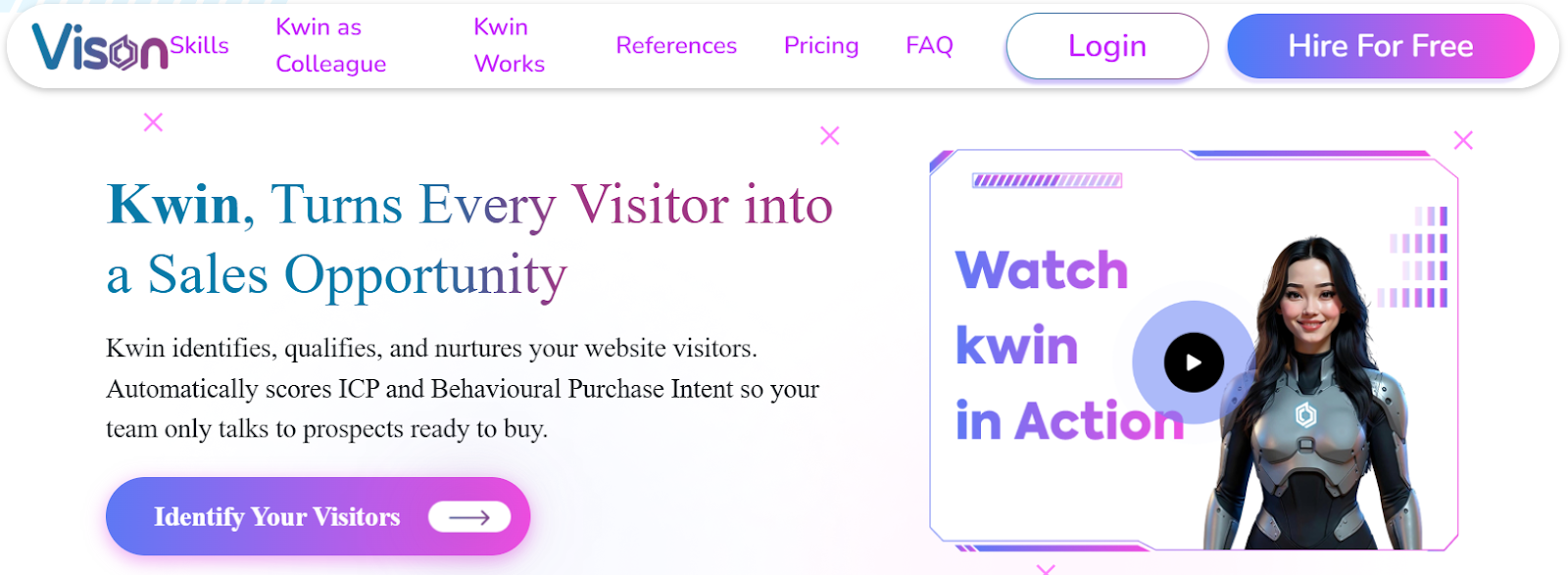In 2025, B2B sales and marketing teams are obsessed with one thing — finding smarter ways to identify and convert website visitors into qualified leads.
For the last couple of years, RB2B has been one of the better-known visitor-identification platforms. It promised to reveal who visits your website and help you follow up. But as buyer expectations evolve and technology advances, many companies are now searching for RB2B alternatives that go beyond data — toward full-funnel automation, AI nurturing, and measurable ROI.
In this guide, we’ll cover the 10 best RB2B competitors in 2025, with Kwin (Vison AI) ranked #1 for combining visitor identification, AI qualification, and automated lead nurturing — all at an SMB-friendly price.
Why Companies Are Looking for RB2B Alternatives
While RB2B introduced useful ideas for B2B marketers, many users report limitations that push them to explore newer platforms. The following drawbacks are compiled from verified reviews and third-party analyses.
1. Limited Visitor Coverage
Several independent benchmarks reveal that RB2B typically identifies only 10–30 percent of total website visitors.
➡️ Source: MadKudu Benchmark Review of RB2B
2. Person-Level Data Restricted to the U.S.
According to user feedback, person-level identification works mainly for U.S. traffic. For international visitors, RB2B often provides only company-level information. Websites getting traffic outside the US won’t be able to use the tool.
➡️ Source: ColdIQ RB2B vs Vector Comparison
3. Data Accuracy and Match Rates
G2 reviews mention mismatched profiles or incomplete records that limit outreach success. Inconsistent matching lowers overall lead quality.
➡️ Source: G2 RB2B User Reviews
4. Limited Automation and Integrations
Although RB2B integrates with some CRMs, automation options remain narrow compared to new AI-driven tools that handle scoring, nurturing, and reporting end-to-end.
RB2B is limited in many terms, because modern B2B teams need smarter tools that not only identify but also engage and qualify prospects automatically.
#1 Kwin (Vison AI) — The Best RB2B Alternative for 2025
#1 Kwin (Vison AI) — The Best RB2B Alternative for 2025
Key Features
Person + Company Identification: Detects not only which company visited but also the professionals behind the visit, globally — not just in the U.S.
AI Lead Scoring: Automatically evaluates visitor intent based on page visits, engagement depth, and session patterns.
Progressive Nurturing: Sends personalized emails and LinkedIn touches that adapt to each lead’s behavior.
CRM Integration: Connects directly with HubSpot, Salesforce, Pipedrive and other dozens of tools to deliver ready-to-act leads.
Real-Time Alerts: Get real time notification of identified leads directly into your Slack.
Affordable for SMBs: Enterprise-level automation at a startup-friendly cost.
Pricing
Starts from $129/month for up to 300 identified and qualified leads with progressive nurturing automation.
Scalable plans available for larger volumes
Pros and Cons
Why Kwin Outperforms RB2B
If RB2B helped teams discover who’s visiting, Kwin helps them close those visitors. By combining AI identification, qualification, and nurturing in one platform, Kwin turns your website into a self-driving lead-generation engine.
👉 Try Kwin Now — Start turning your anonymous traffic into sales conversations today.
#2 Warmly
Warmly helps sales teams turn anonymous visitors into named contacts and meeting-ready prospects. The platform focuses on personalization, giving reps real-time alerts about who’s engaging with their site so they can reach out faster.
Key Features
Instant Visitor ID: Identifies companies and key decision-makers visiting your website.
Personalized Prospect Insights: Shows LinkedIn data, title, and intent to improve outreach.
Live Notifications: Alerts sales reps in real time.
Integrations: Connects with HubSpot, Salesforce, and outreach tools like Apollo.
Pricing
They have annual contracts starting from $10,000 USD per year.
The 3 annual plans they have are Data Agent Plan ($10,000 USD), Outbound Agent Plan ($16,000 USD), Inbound Agent Plan ($22,000 USD)
Pros and Cons
#3 Factors.ai
Source: factors.ai
Factors.ai focuses on bridging analytics and B2B intent data. It gives marketing and revenue teams insights into which campaigns drive actual pipeline impact and helps identify which accounts show strong buying signals.
Key Features
Account Identification: See which companies engage with your website.
Pipeline Attribution: Understand which campaigns and touchpoints drive conversions.
AI-Powered Insights: Predicts which accounts are ready to buy based on engagement.
CRM Integrations: Syncs directly with HubSpot and Salesforce.
Pricing
Currently they are not displaying any pricing on their website.
Previously their pricing was based on traffic and number of accounts tracked (starting around $549/month).
Pros and Cons
#4 ZoomInfo
Source: zoomInfo
ZoomInfo is one of the most established names in B2B data intelligence. It provides detailed company and contact data along with tools for outbound prospecting and website visitor identification (via ZoomInfo WebSights).
Key Features
Massive Database: Over 100 million business contacts and 70 million company profiles.
WebSights Module: Identifies anonymous website visitors and maps them to verified company data.
Intent Signals: Tracks buying behavior and keyword intent to prioritize outreach.
Integrations: Seamless with Salesforce, HubSpot, Outreach, and Marketo.
Pricing
ZoomInfo has three paid plans to choose from – Sales, Marketing, and Talent.
Pricing is quote-based; typical business plans start at $10,000 USD/year.
Pros and Cons
#5 Lusha
Source:lusha
Lusha helps B2B sales teams find accurate contact data fast. It’s primarily a data enrichment and email-finding tool but has recently added features for website visitor identification and intent-based prospecting. It is a good alternative to RB2B.
Key Features
Contact Finder: Instantly retrieves verified phone numbers and emails.
Visitor Reveal: Identifies which companies visit your site.
CRM Integrations: Works with Salesforce, HubSpot, and Outreach.
Browser Extension: Capture lead data directly from LinkedIn.
Pricing
Free plan with 40 credits/month
Paid plans start at $29.90/month.
Pros and Cons
#6 Seamless.AI
Source: seamless.ai
Seamless.AI positions itself as an AI-powered contact discovery engine for B2B sales professionals. It uses real-time verification to help reps find and connect with potential customers.
Key Features
AI-Powered Database: Updated in real-time to ensure contact accuracy.
LinkedIn Integration: Prospect directly from social profiles.
Chrome Extension: One-click data capture from any webpage.
CRM Sync: Exports directly into Salesforce and HubSpot.
Pricing
Free version with 50 credits
They have 3 paid plans with custom pricing. No pricing details mentioned on their website.
Pros and Cons
#7 Kwanzoo
Source:kwanzoo
Kwanzoo is an account-based marketing (ABM) and demand generation platform that focuses on connecting ad engagement data with sales intent. It’s built for enterprise B2B companies with longer sales cycles.
Key Features
Account Identification: Matches website visitors to accounts.
Intent-Based Advertising: Runs targeted display campaigns.
Pipeline Attribution: Links ad spend to conversions.
Integration Ecosystem: Works with major CRMs and Marketing Automation Platforms.
Pricing
Custom enterprise pricing; typically starts around $500 USD/month for 750 credits.
Pros and Cons
#8 Lead Forensics
Source:lead forensics
Lead Forensics is one of the oldest names in website visitor tracking. It identifies companies visiting your website and provides their firmographic data for sales outreach.
Key Features
Company-Level Visitor Reveal: Identifies businesses visiting your site in real-time.
Detailed Insights: Shows visit duration, page paths, and engagement patterns.
CRM Integrations: Connects with Salesforce and HubSpot.
Custom Alerts: Notify sales teams about target accounts.
Pricing
Custom pricing based on website traffic.
Pros and Cons
#9 RocketReach
Source:RocketReach
RocketReach is primarily a contact lookup tool for finding professional emails and phone numbers. While not a full visitor identification tool, it’s popular among SDRs for outbound prospecting.
Key Features
Contact Search: Over 700 million professionals and 35 million companies.
Email Verification: Ensures deliverability.
API Access: For enrichment and integration.
Chrome Extension: Collect leads directly from LinkedIn.
Pricing
Essential plan at $99/month.
Pro plan at $165/month.
Ultimate plan at $300/month.
Pros and Cons
#10 Dealfront (formerly Leadfeeder)
Source:dealfront
Dealfront, formerly known as Leadfeeder, identifies anonymous website visitors and reveals which companies are showing buying intent. It combines firmographic data with advanced filters and CRM integrations.
Key Features
Company Identification: Shows which organizations visited your site.
Engagement Scoring: Ranks visitors by interest level.
CRM Sync: Works with HubSpot, Pipedrive, and Salesforce.
Integrations: Connects with Slack and Zapier for instant alerts.
Pricing
No pricing mentioned on the website.
Pros and Cons
Top RB2B Alternatives at a Glance
What Real Businesses Improve When They Know Who Visits Their Website
Most B2B companies invest thousands of dollars in ads, SEO, and social media to drive traffic to their websites.
But here’s the uncomfortable truth: if you don’t know who is visiting your website, 95% of that traffic is wasted.
When businesses begin identifying website visitors, everything changes.
1. Visibility Turns into Actionable Insights
Instead of just seeing numbers in Google Analytics, you start seeing company and professionals names, job titles, and industries. This allows marketing teams to tailor content, sales teams to personalize outreach, and leadership to forecast pipeline more accurately.
2. Faster Follow-Up, Stronger Conversions
Timing matters. When sales teams get real-time alerts about visitors exploring your pricing page, they can reach out while interest is still high.Tools like Kwin handle this automatically — nurturing visitors via email or LinkedIn, then handing off qualified leads to human reps.
3. Marketing ROI Becomes Measurable
By connecting visitor data with campaign performance, businesses can finally tie their marketing spend to sales outcomes.This clarity allows you to scale what works and stop wasting money on what doesn’t.
4. Alignment Between Sales and Marketing
When both teams see the same visitor data — who visited, what they viewed, and how engaged they were — they can work together seamlessly.Marketing generates higher-quality leads, and sales closes them faster.
5. Consistent Growth, Powered by Automation
AI platforms like Kwin remove repetitive manual work.From identifying who visits your website to nurturing them automatically, Kwin ensures that no lead is ever lost in the dark again.
Final Thoughts
The world of B2B lead generation has evolved beyond static data and manual follow-ups. While RB2B helped companies see who was visiting, today’s market demands more — automation, accuracy, and action.
Kwin (Vison AI) isn’t just another RB2B competitor; it’s the next evolution in AI-driven business development. It identifies, qualifies, nurtures, and hands off hot leads — all without human intervention.
👉 Sign up for Kwin today and let your AI Business Developer turn your anonymous website visitors into real opportunities.
Because in 2025, the fastest-growing B2B companies don’t just capture traffic — they convert it intelligently.




